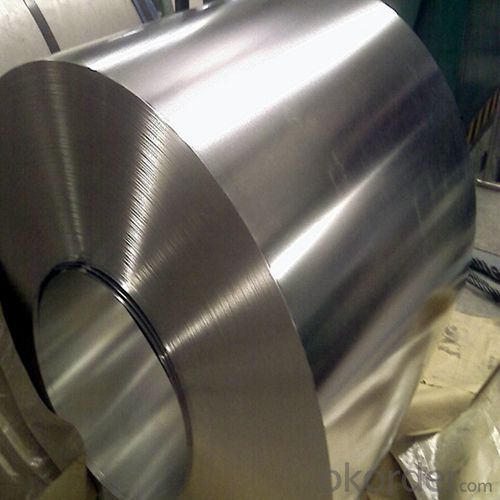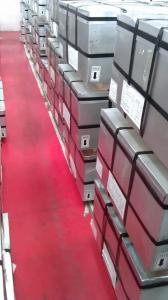Electrolytic Tinplate for Foods Tin Cans Making
- Loading Port:
- Tianjin
- Payment Terms:
- TT OR LC
- Min Order Qty:
- 25 m.t
- Supply Capability:
- 7000 m.t/month
OKorder Service Pledge
OKorder Financial Service
You Might Also Like
1.Structure of Electrolytic Tinplate for Foods Tin Cans Making Description
Electrolytic Tin Plate Coils and Sheets for Foods Metal Packaging, is one thin steel sheet with a coating of tin applied by electrolytic deposition. Tinplate made by this process is essentially a sandwich in which the central core is strip steel. This core is cleaned in a pickling solution and then fed through tanks containing electrolyte, where tin is deposited on both sides. As the strip passes between high-frequency electric induction coils, it is heated so that the tin coating melts and flows to form a lustrous coat.
2.Main Features of the Electrolytic Tinplate for Foods Tin Cans Making
Appearance – Electrolytic Tin Plate is characterized by its beautiful metallic luster. Products with various kinds of surface roughness are produced by selecting the surface finish of the substrate steel sheet.
Paintability and printability – Electrolytic Tin Plates have excellent paintability and printability. Printing is beautifully finished using various lacquers and inks.
Formability and strength – Electrolytic Tin Plates have got very good formability and strength. By selecting a proper temper grade, appropriate formability is obtained for different applications as well as the required strength after forming.
Corrosion resistance – Tinplate has got good corrosion resistance. By selecting a proper coating weight, appropriate corrosion resistance is obtained against container contents. Coated items should meet 24 hour 5 % salt spray requirement.
Solderability and weldability – Electrolytic Tin Plates can be joined both by soldering or welding. These properties of tinplate are used for making various types of cans.
Hygienic – Tin coating provides good and non toxic barrier properties to protect food products from impurities, bacteria, moisture, light and odours.
Safe – Tinplate being low weight and high strength makes food cans easy to ship and transport.
Eco friendly – Tinplate offers 100 % recyclability.
Tin is not good for low temperature applications since it changes structure and loses adhesion when exposed to temperatures below – 40 deg C.
3.Electrolytic Tinplate for Foods Tin Cans Making Images



4.Electrolytic Tinplate for Foods Tin Cans Making Specification
Standard | ISO 11949 -1995, GB/T2520-2000,JIS G3303,ASTM A623, BS EN 10202
|
Material | MR,SPCC |
Thickness | 0.15mm - 0.50mm |
Width | 600mm -1150mm |
Temper | T1-T5 |
Annealing | BA & CA |
Coil Inner Diameter | 508mm |
Weight | 6-10 tons/coil 1~1.7 tons/sheets bundle |
Passivation | 311 |
Oil | DOS |
Surface | Finish,bright,stone,matte,silver |
5.FAQ of Electrolytic Tinplate for Foods Tin Cans Making
-How to place .an order or contact you ?
Please send us Email. we will give you a quick response in seconds .
- How is your quality ?
All our quality is prime even the secondary quality . We have many years experience
In this field with serious quality control standard . Advanced equipment, We welcome your visit to our factory .
- Q: A tin rust problem for help
- Once the outer rust rust, if the area is not large, can use sandpaper to rub the rust, and then wipe clean towel can surface, then coated with a layer of antirust oil; if the outer rust area of about 1/2, we must take into account whether the corrosion to the inner wall, has affected the quality of the contents. If rust occurs on the inside, you need to remove all the rework, tank canning, liquid injection, degassing, sealing and sterilization, cooling, after 2 times of high temperature sterilization of canned products, generally need to downgrade, or if some products in the two sterilization will appear after taste and color changes, you need to direct rejection.
- Q: Can tinplate be used for packaging products with sharp edges?
- Yes, tinplate can be used for packaging products with sharp edges. Tinplate is known for its durability and strength, making it suitable for packaging products that have sharp edges without causing any damage to the packaging material.
- Q: Tin cans and tin cans, which is good?
- I think this question is not asked to tin tin, chrome tin and galvanized tin which is the best? Of course, the best is galvanized iron. The second is the tin tin, followed by chrome tin, iron box is made finally.
- Q: What are the different tinplate surface finishes?
- There are several different tinplate surface finishes available, including bright finish, stone finish, matte finish, and lacquered finish. These finishes offer various levels of shine and texture, allowing for different aesthetic and functional purposes in the tinplate industry.
- Q: What are the regulations and standards related to tinplate packaging?
- Regulations and standards related to tinplate packaging may vary depending on the specific country or region. However, in general, tinplate packaging is subject to regulations and standards related to food safety, product labeling, and environmental concerns. These regulations ensure that tinplate packaging materials are safe for food contact and that they comply with specific guidelines for packaging materials. Additionally, there may be standards regarding the thickness, coating, and overall quality of tinplate packaging to ensure its durability and performance.
- Q: How does tinplate affect the environment?
- Tinplate can have both positive and negative impacts on the environment. On one hand, tinplate is a highly recyclable material, which helps reduce the demand for new raw materials and decreases waste generation. Additionally, tinplate is often used as a protective coating on steel cans, preventing corrosion and extending their lifespan. This contributes to reducing the need for frequent replacements and conserving resources. However, the production of tinplate involves mining and refining tin ore, which can lead to habitat destruction, soil erosion, and water pollution if not managed properly. Furthermore, the manufacturing process may emit greenhouse gases and other air pollutants. Overall, the impact of tinplate on the environment depends on various factors, including its lifecycle management and the efficiency of recycling processes.
- Q: Can tinplate packaging be used for microwaveable products?
- No, tinplate packaging cannot be used for microwaveable products as it is a metal material and can cause sparks or fires in the microwave.
- Q: What's the head iron?
- SPTE, which is commonly known as tin, tin plate, thickness of 0.15-0.3mm, width, generally between 300-900mm.
- Q: Can tinplate be recycled with other metals?
- Yes, tinplate can be recycled with other metals. Tinplate is typically made from steel coated with a thin layer of tin, and both steel and tin can be recycled. When tinplate is recycled, it is usually separated from other materials and processed separately to recover the steel and tin content.
- Q: How is tinplate coated with water-based paints?
- Tinplate is coated with water-based paints using a process called coil coating. In this process, the tinplate is cleaned and then coated with a primer layer, which helps in improving adhesion. After the primer layer, multiple layers of water-based paints are applied using rollers or spray techniques. These layers are then dried and cured to form a strong and durable coating on the tinplate surface.
Send your message to us
Electrolytic Tinplate for Foods Tin Cans Making
- Loading Port:
- Tianjin
- Payment Terms:
- TT OR LC
- Min Order Qty:
- 25 m.t
- Supply Capability:
- 7000 m.t/month
OKorder Service Pledge
OKorder Financial Service
Similar products
Hot products
Hot Searches
Related keywords

























